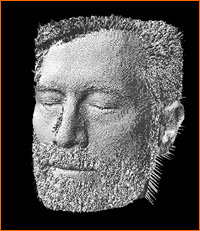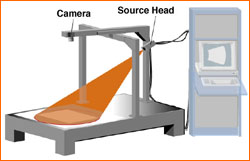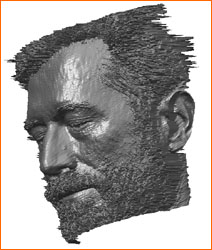
|
 |
 |
by Rob Meyer Sam Reese Sheppard, who has long maintained that his father, Dr. Sam Sheppard, had nothing to do with the killing of Mrs. Sheppard on a July night 45 years ago, might well have wished that a crime-fighting tool now under development at MIT's Lincoln Laboratory existed back in 1954. Because that tool is sophisticated enough that, if it had been employed at the Sheppard crime scene, it would very likely have ferreted out evidence missed by investigators of the day - evidence that might have altered the jury's decision. The tool in question is a laser-imaging system that provides pictures in three dimensions of target objects using a technique known as Accordion Fringe Interferometry (AFI). Nathan Derr, a physicist and member of the team that invented AFI, says that in the future, detectives might bring a portable version of one of these 3-D cameras to crime scenes, where they could photograph everything from footprints to tooling marks - scratches or nicks left by tools or other hard objects. The system is quick - producing a picture takes seconds - and its images are sharp: each is accurate to 200 microns, or one-fifth of a millimeter. Further, the device does not damage or contaminate the evidence itself, allowing future detectives the ability to, as environmentalists like to say, "take only photographs."
Acquiring and processing all the data necessary to render an image precisely in 3-D used to take weeks; using the Lincoln Laboratory technique, a computer can record all of the necessary information in seconds. The subject sits in a dentist's chair facing a camera, all but oblivious to a zebra pattern of near-infrared light illuminating his face. The system takes a rapid series of still images and sends the information to a computer, which runs some novel processing algorithms developed by Dr. Lyle Shirley, head of the group that invented AFI. Within seconds, a 3-D rendering of the subject's head appears on the screen. (Presently, the engineers are unable to capture the very back of the head, but they're exploring the possibility of taking two such pictures simultaneously in order to get a full 360° view.)
Soon, too, they hope to produce such 3-D mug shots in color. Because their system records the x, y, and z coordinates of every point on the face, they feel confident that, with the proper equipment, they should be able to record the color values for every point as well, offering photo-realistic renderings in full, living color. Authorities could install such a useful instrument in police stations, where suspects would supply fingerprints, then sit in a special chair for a 3-D mug. Continue: So how does AFI work? Chronology of a Murder | Science in the Courtroom Create a DNA Fingerprint | 3-D Mug Shot | Cleared by DNA Resources | Transcript | Site Map Editor's Picks | Previous Sites | Join Us/E-mail | TV/Web Schedule About NOVA | Teachers | Site Map | Shop | Jobs | Search | To print PBS Online | NOVA Online | WGBH © | Updated November 2000 |
 Prototype of a 3-D mug shot, using an MIT researcher
as subject. Note that because of loading-time limits
on the Web, this image is of a far lower resolution
than the actual image.
Prototype of a 3-D mug shot, using an MIT researcher
as subject. Note that because of loading-time limits
on the Web, this image is of a far lower resolution
than the actual image. Diagram of a prototype AFI system that NOVA Online
observed at work in the basement of MIT's Lincoln
Laboratory.
Diagram of a prototype AFI system that NOVA Online
observed at work in the basement of MIT's Lincoln
Laboratory.
 Varying the light source could help witnesses
identify suspects.
Varying the light source could help witnesses
identify suspects.